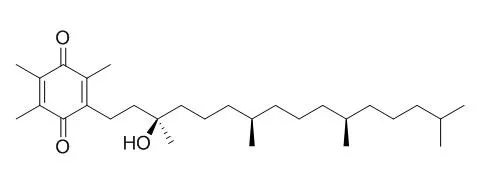| Cell Research: |
| Cancer Lett. 1982 Feb;15(2):173-8. | | Regulation of cell division in a human glioma cell clone by arachidonic acid and alpha-tocopherolquinone.[Pubmed: 6284351] | A human glioma cell clone (12-18 CV), derived from a previously characterized glioblastoma multiforme cell line, was established in culture.
METHODS AND RESULTS:
Lipid peroxidation (thiobarbituric acid test) occurred when either 8,11,14-eicosatrienoic acid or 5,8,11-eicosatetraenoic acid (arachidonic acid) was added to the cells in culture. The extent of lipid peroxidation was similar in fetal brain cells (CH II) treated with these polyunsaturated fatty acids. The antioxidant, alpha-Tocopherolquinone, inhibited lipid peroxidation in both the glioma cell clone and fetal brain cells. Arachidonic acid significantly reduced cell division in both the glioma cell clone and fetal brain cells. alpha-Tocopherolquinone restored cell division to control levels in both cultures.
CONCLUSIONS:
These data show that cells from a tumor clone retain the capacity for lipid peroxidation. Furthermore, cell division in a tumor clone is correlated with lipid peroxidation in the same way that cell division in other cell lines is correlated with lipid peroxidation. | | Neurochem Int. 2010 Dec;57(8):914-22. | | α-Tocopherolquinone inhibits β-amyloid aggregation and cytotoxicity, disaggregates preformed fibrils and decreases the production of reactive oxygen species, NO and inflammatory cytokines.[Pubmed: 20933033 ] | Alzheimer's disease (AD) is a complex, multifactorial neurodegenerative disease. The aggregation of beta-amyloid (Aβ) into extracellular fibrillar deposition is a pathological hallmark of AD. The Aβ aggregate-induced neurotoxicity, inflammatory reactions and oxidative stress are linked strongly to the etiology of AD.
The currently available hitting-one-target drugs are insufficient for the treatment of AD. Therefore, finding multipotent agents able to modulate multiple targets simultaneously is attracting more attention.
Previous studies indicated that vitamin E or its constituent such as α-tocopherol (α-T) was able to attenuate the effects of several pathogenetic factors in AD. However, ineffective or detrimental results were obtained from a number of clinical trials of vitamin E.
METHODS AND RESULTS:
Here, we showed that naturally synthesized RRR-alpha-Tocopherolquinone(α-TQ), a main derivative of α-T, could inhibit Aβ42 fibril formation dose-dependently. Further investigations indicated that α-TQ could attenuate Aβ42-induced neurotoxicity toward SH-SY5Y neuroblastoma cells, disaggregate preformed fibrils and interfere with natural intracellular Aβ oligomer formation. Moreover, α-TQ could decrease the formation of reactive oxygen species (ROS) and NO, and modulate the production of cytokines by decreasing TNF-α and IL-1β and increasing IL-4 formation in microglia.
CONCLUSIONS:
Taken together, α-TQ targeting multiple pathogenetic factors deserves further investigation for prevention and treatment of AD. |
|






 Cell. 2018 Jan 11;172(1-2):249-261.e12. doi: 10.1016/j.cell.2017.12.019.IF=36.216(2019)
Cell. 2018 Jan 11;172(1-2):249-261.e12. doi: 10.1016/j.cell.2017.12.019.IF=36.216(2019) Cell Metab. 2020 Mar 3;31(3):534-548.e5. doi: 10.1016/j.cmet.2020.01.002.IF=22.415(2019)
Cell Metab. 2020 Mar 3;31(3):534-548.e5. doi: 10.1016/j.cmet.2020.01.002.IF=22.415(2019) Mol Cell. 2017 Nov 16;68(4):673-685.e6. doi: 10.1016/j.molcel.2017.10.022.IF=14.548(2019)
Mol Cell. 2017 Nov 16;68(4):673-685.e6. doi: 10.1016/j.molcel.2017.10.022.IF=14.548(2019)